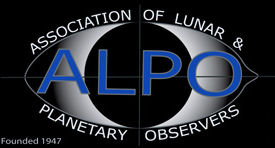 Association
of Lunar and Planetary Observers
Association
of Lunar and Planetary Observers 2011 Conference
July 20-23, 2011
Las Cruces, New Mexico
 Association
of Lunar and Planetary Observers
Association
of Lunar and Planetary Observers | Conference Overview |
NMSU Campus |
Conference Information |
Lodging | Excursions | Registration Form |
 The Astronomical Society of Las Cruces and the Astronomy Department
of New Mexico State University proudly announce the 2011 Conference of the
Association of Lunar and Planetary Observers to be held on the New Mexico State
University campus in Las Cruces, New Mexico from Wednesday, July 20, 2011 to
Saturday, July 23, 2011. This beautiful campus on the south side of Las Cruces
has the Organ Mountains as a backdrop to the campus activities.
The Astronomical Society of Las Cruces and the Astronomy Department
of New Mexico State University proudly announce the 2011 Conference of the
Association of Lunar and Planetary Observers to be held on the New Mexico State
University campus in Las Cruces, New Mexico from Wednesday, July 20, 2011 to
Saturday, July 23, 2011. This beautiful campus on the south side of Las Cruces
has the Organ Mountains as a backdrop to the campus activities. 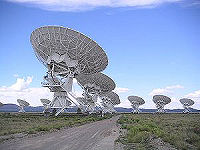 The
one of the highlights of this year's conference is the opportunity to visit the
Very Large Array (VLA) near Socorro, New Mexico. The VLA is one of the world's
premier astronomical radio observatories, consisting of 27 radio antennas in a
Y-shaped configuration on the Plains of San Agustin, fifty miles west of
Socorro, New Mexico. Each antenna is 25 meters (82 feet) in diameter. The data
streams from the different antennas are combined electronically to give the
resolution of an antenna 36km (22 miles) across, with the sensitivity of a dish
130 meters (422 feet) in diameter. This excursion will also include a stop at
the Pete V. Domenici Sciences Operations Center in Socorro where equipment for
the VLA are maintained.
The
one of the highlights of this year's conference is the opportunity to visit the
Very Large Array (VLA) near Socorro, New Mexico. The VLA is one of the world's
premier astronomical radio observatories, consisting of 27 radio antennas in a
Y-shaped configuration on the Plains of San Agustin, fifty miles west of
Socorro, New Mexico. Each antenna is 25 meters (82 feet) in diameter. The data
streams from the different antennas are combined electronically to give the
resolution of an antenna 36km (22 miles) across, with the sensitivity of a dish
130 meters (422 feet) in diameter. This excursion will also include a stop at
the Pete V. Domenici Sciences Operations Center in Socorro where equipment for
the VLA are maintained.
Another excursion will take us to the National Solar Observatory
at Sunspot, New Mexico in the Lincoln National Forest. This facility utilizes
the clear New Mexico skies to keep an eye on our nearest star, the Sun. The
principle instrument is the Richard B. Dunn Solar Telescope, a unique
vertical-axis solar telescope. The optical path starts at a heliostat on top of
a 136-foot-tall (41 m) tower and continues 193 feet (58.8 m) further
underground to the primary mirror. It then returns to one of six quartz optical
windows in the floor of an optical laboratory at ground level. The optics are
evacuated to eliminate distortion due to convection in the telescope that would
otherwise be caused by the great heat produced by focusing the light of the
sun. A unique feature of the telescope is its approach to image derotation: the
entire 100-meter-long (330 ft) telescope and 40-foot-diameter (12 m) optics
lab, 250 tons total, rotates, suspended from a mercury float bearing at the top
of the tower.
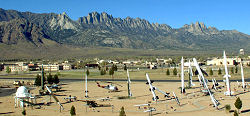 We
will also stop at the White Sands Missle Range Museum, the Home of America's
Space Program. At the outdoor Missle Park we will see the various vehicles that
have been tested at White Sands. Also on display is a German V-2 missle that is
similar to the V-2s tested at White Sands after World War II. The museum
includes various artifacts from White Sands and the Space Program. Since 1945,
the missile range has conducted more than 42,000 missile and rocket firings. In
addition to examining new weapon systems for the military, the range also
conducts purely scientific research. Rocket payloads from NASA are regularly
launched to collect information about the Sun and stars or conduct microgravity
experiments.
We
will also stop at the White Sands Missle Range Museum, the Home of America's
Space Program. At the outdoor Missle Park we will see the various vehicles that
have been tested at White Sands. Also on display is a German V-2 missle that is
similar to the V-2s tested at White Sands after World War II. The museum
includes various artifacts from White Sands and the Space Program. Since 1945,
the missile range has conducted more than 42,000 missile and rocket firings. In
addition to examining new weapon systems for the military, the range also
conducts purely scientific research. Rocket payloads from NASA are regularly
launched to collect information about the Sun and stars or conduct microgravity
experiments.
We have made arangements for a reduced-rate block of rooms at the Sleep Inn-University near the New Mexico State University campus. This is a change from what was published in the Journal of the A.L.P.O. We also have made arrangements with the University to make a block of dorm rooms available. You may also stay in any of the many hotels and motels in the Las Cruces area.
Las Cruces is located at the crossroads of Interstate 10 and 25 brings visitors into contact with 72 holes of spectacular year-round golf, historic attractions such as Old Mesilla - not to mention world-class Mexican food! Las Cruces also blends a unique variety of attractions, culture, historical sites and superb year-round weather with 350 days of sunshine (and starshine) per year.
If you are flying in to the Conference, the nearest airport with major airlines is El Paso, Texas. El Paso is about fifty miles south of Las Cruces and you can make the trip by car in about an hour. There is also a shuttle bus service (Las Cruces Shuttle and Taxi Service) that will bring you to the Las Cruces area if you do not plan to rent a car. Las Cruces does not have passenger rail service, but Amtrack's Texas Eagle does stop in El Paso as well.
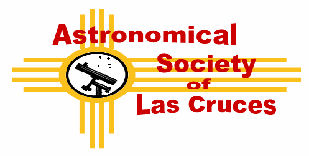
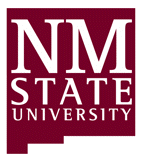 The
2011 Association of Lunar and Planetary
Observers conference is sponsored by the Astronomical Society of Las Cruces and The Astronomy
Department of New Mexico State University.
The
2011 Association of Lunar and Planetary
Observers conference is sponsored by the Astronomical Society of Las Cruces and The Astronomy
Department of New Mexico State University.Last Updated May 1, 2011
Copyright by the respective copyright holders or by Berton Stevens, 2011